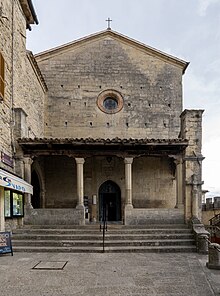San Francesco, San Marino
- View a machine-translated version of the Italian article.
- Machine translation, like DeepL or Google Translate, is a useful starting point for translations, but translators must revise errors as necessary and confirm that the translation is accurate, rather than simply copy-pasting machine-translated text into the English Wikipedia.
- Do not translate text that appears unreliable or low-quality. If possible, verify the text with references provided in the foreign-language article.
- You must provide copyright attribution in the edit summary accompanying your translation by providing an interlanguage link to the source of your translation. A model attribution edit summary is
Content in this edit is translated from the existing Italian Wikipedia article at [[:it:Chiesa di San Francesco (San Marino)]]; see its history for attribution. - You may also add the template
{{Translated|it|Chiesa di San Francesco (San Marino)}}to the talk page. - For more guidance, see Wikipedia:Translation.

Chiesa di San Francesco is a church in San Marino. It belongs to the Roman Catholic Diocese of San Marino-Montefeltro. It was built in 1361.[1]

The church of San Francesco is a church in the city of San Marino.
The adjoining convent and the church were initially based in Murata, near the city of San Marino, but then Pope Clement VII granted the displacement of the church and convent in the city of San Marino Murata because there was danger of raids by Malatesta.
Construction was begun in 1351 and completed around 1400, were used for the construction materials of the church and the convent suppressed. The rose window was covered in the seventeenth century it was brought to light last renovation performed by Gino Zani and brought back largely to the original lines. The construction workers attended both San Marino Comacine fact it includes the names of Mastro Baptist from Como and Mastro Manetto Samamrinese. In the cloister is the tomb of Bishop Marino Madroni, lived in the fifteenth century that belonged to the Franciscan friars. Museum in the adjacent St. Francis are preserved paintings by Guercino and Raphael.
References
- ^ Birnbaum, S. (1989). Birnbaum's Italy, 1990. Houghton Mifflin Company. p. 596. ISBN 978-0-395-51151-0. Retrieved 4 June 2019.
En Route from Borgo Maggiore – San Marino can be reached by foot along the short cut called the Costa, by car, or by cable car. ... Once inside, to the right, is the convent and the small Chiesa di San Francesco, both founded in 1361.
43°56′07″N 12°26′50″E / 43.9353°N 12.4471°E / 43.9353; 12.4471
- v
- t
- e













